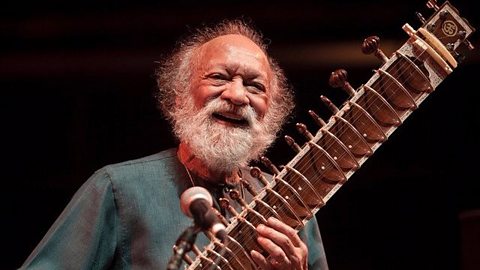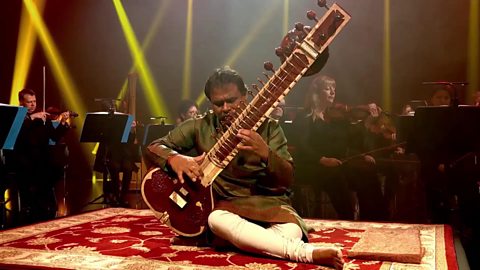Dates: b. 1920 / d. 2012
Nationality: Indian
Period: 20th Century
Genre: Symphony
Key Musical Elements:
- Pitch
- Melodic Shape
- Duration
- Metre / Rhythm

Why is he a Trailblazer?
The most famous sitar player of all time, trailblazer Ravi Shankar shared his passion for the sound and traditions of Hindustani classical music with the whole world.
In his Symphony Ravi Shankar explores this passion using the traditional instruments of a large Western orchestra.
Listen out for:
The sitar and orchestra play melodies based on a raga (a pattern or selection of notes that form the basis of a composition) inspired by the Banjara people of India. Can you hear that some of the notes are higher than others? The pattern of notes on the sitar are then given to other instruments of the orchestra.
The rhythm played on the tabla or drums is shared out among many different orchestral instruments, like the xylophone and the French horns. Then Shankar asks the players to sing a tala using Indian drum syllables.
Explore Ravi Shankar’s Symphony – Finale. Learn about Hindustani music, the raga (melody) and tala (rhythm) that shapes the piece, and also the Banjara people who inspired it.
Fast Facts
The young Ravi Shankar travelled to Paris, performing in his older brother’s dance group. During the group’s tours of Europe and the USA, Shankar heard Western orchestras and jazz music.
Shankar gave up dancing to study Hindustani classical music and, by the mid 1950s, was playing the sitar in concerts around the world.
Shankar’s early curiosity for other musical styles and musicians from other traditions never left him – and he collaborated with many people, including violinist Yehudi Menuhin and composer Philip Glass.
In the 1960s Beatles guitarist George Harrison was introduced to Shankar’s music. He used the sitar in some recordings and, along with other groups like the Rolling Stones, helped Indian music reach huge new audiences.
Sitar player Gaurav Mazumdar joins the ≥…»ÀøÏ ÷ Scottish Symphony Orchestra to perform an excerpt from the finale of Ravi Shankar‚Äôs Symphony, conducted by Roderick Cox.
Symphony – finale – Banjara
Two of the key ideas of Hindustani classical music (raga and tala) are found in the finale of Ravi Shankar’s Symphony.
The sitar and orchestra play melodies based on a raga (a pattern or selection of notes that form the basis of a composition) inspired by the Banjara people of India.
Shankar also takes tala (rhythmic cycles) that would normally be performed on the tabla or drums and shares them out among many different orchestral instruments, like the xylophone and the French horns.
Then – almost certainly a first for a Western orchestra – he asks the players to sing a tala using Indian drum syllables.
The result is that we hear the orchestra in a new and startling way. By fusing the classical traditions of India and Europe, Shankar managed to create a piece that is uplifting and unique.
Resources
KS2 Lesson plans
Explore and download lesson plans for six weeks of learning and activities for Symphony by Ravi Shankar.

KS3 Lesson plans
Explore and download lesson plans for six weeks of learning and activities for Symphony by Ravi Shankar.

Ready-made secondary music lesson - Create your own tala
Explore and create your own tala taking inspiration from a piece of music by world-famous sitar player, Ravi Shankar.

Explore and download powerpoint slides for six weeks of learning and activities for Ravi Shankar – Symphony – finale (excerpt).

Explore and download powerpoint slides for six weeks of learning and activities for Ravi Shankar – Symphony – finale (excerpt).

Download the audio version.

Downloadable .zip file containing arrangement and Ravi Shankar files. This arrangement is for Grade 4/5 only, owing to the complexity of the piece.

KS3 Bitesize Ten Pieces study guide
Your students can create their own composition at their own pace with this Bitesize Key Stage 3 guide.

Where next?
Why not hear how travels to America influenced another composer in Dvorak’s Symphony No.9, From the New World?
Or you could explore how Bizet’s Habanera from Carmen conjures up the music of another culture – Spain.
Get creative and upload your responses using the Ten Pieces Uploader!
Upload and showcase your creative responses
Upload your creative responses to the Ten Pieces repertoire for your chance to feature in the Ten Pieces creative showcase.
